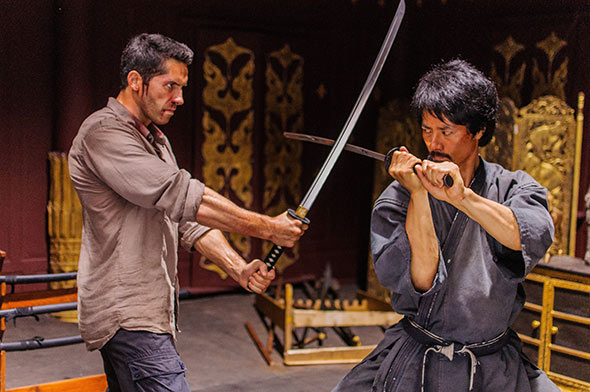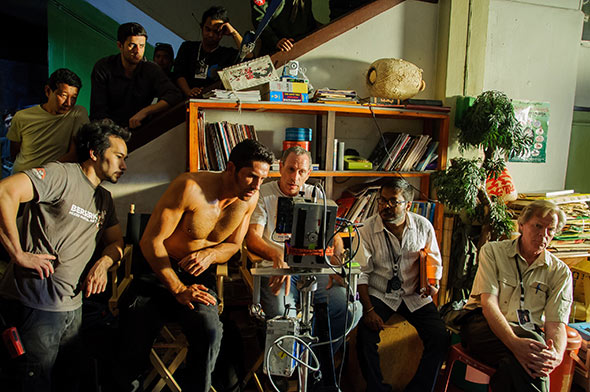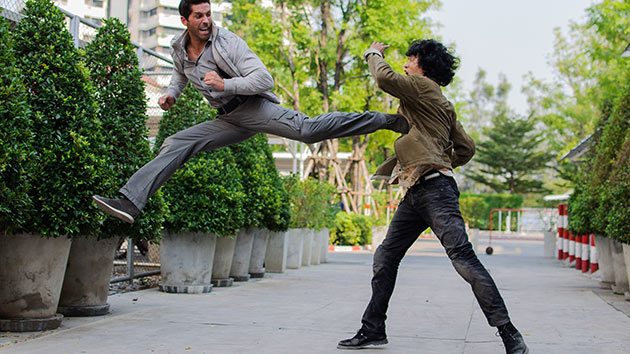Low-Budget Filmmaking, Switching to Digital, and Understanding Martial Arts
Isaac Florentine’s work ought to be far more mainstream than it actually is. His action movies, with one exception, have been released straight to home video in the U.S., although they’re far better crafted than many Hollywood blockbusters. A trained martial artist himself (he was inspired to learn karate when he saw
Enter the Dragon as a teenager in his native Israel), Florentine directs action scenes with a sense of clarity missing from contemporary Hollywood genre fare. Rather than shakycam close-ups, he shoots many relatively long takes in which one can see the actors really grappling. The narratives of his films may be fanciful — the most recent,
Ninja 2: Shadow of a Tear, is about an American man (Scott Adkins) who runs a martial arts dojo in Japan and gets in over the head when he seeks answers and revenge after the murder of his wife — but Florentine’s treatment of violence has a dimension of reality, aided by his casting of actors with an athletic background. Certain film buffs are never going to take a movie called
Ninja 2: Shadow of a Tear seriously, but Florentine’s films deserve to break from the direct-to-video pack. He’s the closest we have to a contemporary
Edgar G. Ulmer.
Studio Daily: Did you start working in 35mm? When did you switch to digital?
Isaac Florentine: I actually worked in 16mm in film school. Already, when I made shorts in Israel, I shot in 16mm reversal. I kept on working with film until I did Undisputed 3 [in 2010]. That was the first time I worked with digital. I used the Red [One] camera. Until then, I was very hesitant about video. I like to play with speed and didn’t like slow-motion video. I was involved around 2000 in a movie that was shot on video, and it didn’t look so good. What I like about digital is that I no longer have to argue with my line producer about wasting stock. Working with digital also gives you more opportunities later in editing, because cropping is easier than working in film. After Undisputed 3, I’ve always used the Red or [ARRI] Alexa. [Ninja 2 was shot with Red Epic cameras.] I don’t want to go back to film. We’re in 1927, when the movies passed from silent to sound.
How did your style of shooting fight scenes in long takes develop?
It was somewhat of a necessity. I did a series called WMAC Masters. It was on Fox, a Saturday-morning show for teenagers. The producers of the show wanted to make it look real, like the World Wrestling Federation. I said to myself, "The only thing that makes fighting look real is no cuts.” In martial arts, you have to take your time to set the shot up to make it realistic. To shoot long takes, you need two capable and qualified things. One is the performers, because they need to be in place and position with full energy. Second, the camera. It doesn’t work with master shots, seeing the action from far. The idea is to glorify the action and tell a story. You need a cameraman that can really shoot it right. I shot it in Orlando, Florida, with a cameraman who was pretty amazing. He managed to understand what I was trying to do, which was really experimental, and did really good things with it. It went really, really well. I was trying to push the envelope as much as I could. The series lasted two seasons, but I started working with Ross Clarkson almost a decade later. He’s an amazing DP and camera operator, so you can really come up with long takes. In every movie, I try to come up with something different. In Ninja 2, there’s a scene in a Japanese dojo where Scott is fighting five men. It lasts almost a minute. Of course, Ross could deliver it. He made that shot happen. It took us nine takes. Two were really amazing.

Do you think your background as a martial artist has influenced your style?
Absolutely, because coming from a traditional karate background from age 13 taught me two things. The picture must be clean. Even when action looks out of control, it has to be precise. The second is that if you understand martial arts, you can be more demanding of the talent about what you want and need. In the beginning, I was also a fight choreographer. At a certain point, once the movies became bigger, I needed to delegate that to someone else. I didn’t want to interfere, but during rehearsal I would give suggestions about the interaction between choreography and the camera, like “Let’s add some steps here so we don’t have to cut.” There’s no doubt that I want to see the technique and geography clearly. People respond to this. Everything in my films make sense. They don’t have to struggle with shaky camera, camera that’s going too tight. Telling the story and framing it right, so the action and fighting can be appreciated, were all attributes that came from martial arts. Coming from Japanese martial arts, I learned precision. All schools of martial arts are good, but very different. Each style has its own flavor and touch. I think a lot about how each segment will cut with the next segment.
If you had a big budget for CG, how would you use it?
I’m not a big fan of CG. It takes you out of reality and looks fake if you rely on it. It’s good for enhancing stuff. If I had a big budget, I would add shooting days. I shoot my movies, and I have 30 days with one unit. I’m running like a dog. When I hear that [The Raid director] Gareth Huw Evans has 70 days or even 120 days, I’m really jealous. To shoot action right, you need time.
What kind of budgetary range have your films been made for?
Low. Not very, very low, but low.
How did your close relationship with [actor] Scott Adkins develop?
We worked together in Special Forces [released in 2003]. I saw Scott by chance through my good friend Don Warner, who’s a martial artist. We used to have a video company that did martial-arts instructional videos. I got sent a VHS tape that Don showed me. I was blown away because Scott had everything I needed. He had the right look, the right moves, the right moves that you need on screen — which are not necessarily the same ones in real life — and he could act. When I was wondering about that, he sent me dramatic scenes from the BBC. In the movie I did right after Special Forces, I showed him to my producer Boaz Davidson, and it was a wonderful experience. On Undisputed 3, he put his heart and soul into the role of Boyka. He’s totally not Boyka, because the original character is ugly and huge. Scott is not that big, he’s not ugly at all, but he managed to create the character. Ever since then, we’ve worked again and again. We’re very good friends. I don’t have to be polite with him, [and] he doesn’t have to be polite with me. We know each other’s strengths and weaknesses. This really helps.

Isaac Florentine (center), surrounded by cast and crew.
Ninja 2 is a pretty scathing depiction of Myanmar. Did you do much research into the country? Where did you actually shoot it?
All of the film is shot in Thailand. The way I show Myanmar is perhaps as if the previous junta is still there. It’s a bit scary. We did some research, but the main revelation was that our casting director went there looking for a Thai or Burmese actor to play the taxi driver. After he returned from Myanmar, he said that there are a lot of taxi drivers from India. That gave us the idea of getting someone from Bollywood to play the character. That’s how we got [Mukesh Bhatt]. We knew that we wanted to make Japan look like a normal, everyday place and as the character grows and his state of mind grows more dark, his surroundings grow darker too. So we brought him to Myanmar.
You worked as a second unit director on Renny Harlin’s The Legend of Hercules, right?
Yes, I was there, but unfortunately, I didn’t manage to help the movie or Harlin. I didn’t do much. I shot for about two weeks, but all I did were beauty and pick-up shots. I wish it were organized as a longer shoot, so I could have taken the load off of Renny, because he was working very hard. The only thing I regret is that my work was like a drop in the bucket.
To what extent do your producers collaborate on the editing of your films?
I usually work with the same editor [Irit Raz]. When I do a movie with Nu Image, I work with producer Boaz Davidson, who is a good friend and a filmmaker himself. I take his opinions very seriously. When I make a film, we sit together and watch it. He has a lot of experience, and every note of his is really important. He’s the man that, at the end, helps to keep me from losing my objectivity.
Steve Erickson is a journalist and film critic based in New York. He writes for Filmmaker, The Village Voice, Nashville Scene, Gay City News, and other publications.












Isaac Florentine is a talented Martial Artist and Film Maker. Having had the pleasure to work with him years ago I know this first hand. Great Article.